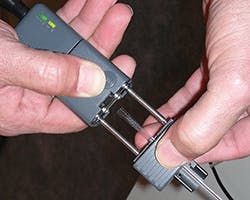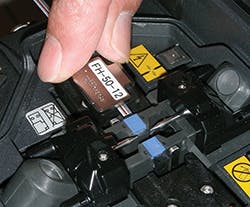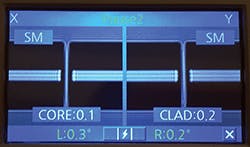To Fiber Splicing Success —
When it comes to splicing fiber, the old adage that "cleanliness is next to godliness" has never been truer. Getting fiber clean before splicing is mission-critical. Dust particles that remain on a fiber cause alignment issues, and degrade the quality and performance of a fusion splice. It is important to ensure operators eliminate all the contamination from the fiber strand before splicing. A clean fiber ensures the optimal optical performance, saves time, and reduces the total expense of fusion-splicing fiber.
Splicing Whaaaat?
Splicing is the process when 2 fiber strands are joined together so the light signal can propagate through the adjoined fibers. There are 2 basic methods for splicing fibers: fusion and mechanical. They both accomplish the same task, which is to join 2 fiber end-faces together with as little insertion loss as possible.
A stripping tool is used to remove the protective sheathing from the fiber. Residues from the sheathing remain on the fiber and need to be cleaned before splicing.
Fusion splicing is the most effective method common for getting the lowest loss values. It is used to join long runs of cables together, and to attach pigtail assemblies to multifiber cables. It is also a common practice during emergency repairs.
The process requires a fusion splicing machine which generates an electrical arc to fuse the ends of the fiber together. Modern fusion splicers are marvels of portability, durability, and micro-miniaturized mechanics. Most fusion splicers on the market today use a cladding alignment system to align the 2 end-faces perfectly. They rely on V-grooves to hold the fibers into place (for single fiber splicing) or a holder with multiple V-grooves for the simultaneous fusing of many fibers in a multi-fiber ribbon system.
Most fusion splicing machines use cameras and a mirror system to align the fibers until they touch. The splicer then uses the heat from the splicer’s electrodes to fuse the ends together. As you might suspect, the software controlling this process is extremely sophisticated. Modern fusion splicers identify and verify the fiber type; align the fibers on the X, Y and Z axis; and adjust the fusion arc, fusion time, and the fiber positioning before and even during the fusion arc process. A modern fusion splicer costs the better part of $10,000.
Mechanical splicing is less sophisticated than fusion splicing. This type of splicing is very similar to field-terminated connector systems. Mechanical splicing enables an operator to quickly and inexpensively convert bulk fiber cable, and to create customized lengths and breakouts for a cable assembly. Another advantage is the ability to replace an individual connector which may have been damaged on multifiber cable assembly.
A strong, lint-free wipe with a non-flammable cleaning fluid can easily remove the residues from the fiber. The best wipes are cellulose-free because fragile cellulose leaves lint on the bare fiber.
The process uses a small plastic core and an exterior housing to hold the 2 fiber ends together. An index matching gel fills the microscopic gap between the two-fiber end-faces which minimizes the overall signal loss. The total cost of the parts is $15 or less.
When preparing for a mechanical splice, there are 3 things to consider: using quality mechanical splice components, ensuring a quality cleave has been performed, and cleaning the fiber of residues which could degrade the splice.
Overall, fusion splicing is generally preferred over mechanical splicing in high volume, high fiber count applications. It has significantly lower signal loss, greater tensile strength, and is more cost-effective over time. Mechanical splices have higher signal losses when compared to fusion splices, but are easier for less-skilled technicians to perform. Also, mechanical splicing kits are much less expensive than fusion splicers.
Cleaning: Does It Really Matter?
So how does cleaning play into either process? The most common reason for high signal losses after splicing is contamination on the fiber. For the optical signal to be received with minimal loss, the fiber must be completely clean of any contaminants.
Once the fiber is cleaned, it is inserted into the cleaving tool and the fiber is sheared cleanly, leaving a perfect end-face with which the splicer can work. (Note: because the fiber is tiny and clear, it is almost invisible, so in this photo a piece of white-sheathed fiber is positioned to show the process.)
It’s odd that in the 21st Century many technicians still have 2 common misconceptions: that cleaning should occur after the cleaving process, or that the heat from the electrical arc obliterates any contamination on the fibers. Both of these assertions are wrong.
The common sources of contamination include dust particles left on the fiber from the stripping process. These particles come from the buffer compound and the acrylate-based coatings used on the fibers. Using cross-contaminated alcohol and cheap, cellulose-based wipes cause water spotting and lint-based contamination.
When using either mechanical or fusion splicing, it’s very important to always clean the fiber before cleaving. Cleaning the fiber after stripping ensures the bare fiber is free of residues. If an operator is using a manual cleaver, it’s important to not exert too much pressure. Excessive pressure causes cracks and surface abnormalities, and leads to rework or repeating of the stripping and cleaving process again. The objective is simply to score the fiber so that it separates cleanly.
But, wait! Here’s an unexpected rule: never clean the fiber end-face after cleaving. The end-face of a freshly cleaved fiber is pristinely clean; cleaning after the process re-contaminates, causing extra work for the operator. It also shortens the lifespan of the splicer’s electrodes, degrades the mechanical strength of the splice, and causes excess signal loss.
Inserting ribbon into fiber fusion splicer.
Remember, it is not just the fiber that should be cleaned. Make sure to clean any equipment being used, including the splicing machine and its V-grooves. To ensure accurate core-to-core alignment, it is critical that the fibers rest unobstructed in the V-groove. Even microscopic traces of dust particulate on the side wall of the groove or the fiber could cause misalignment.
Operators also must maintain the cleanliness of the splicing chamber, the V-grooves, the electrodes, the camera lenses, and the mirrors inside the fusion splicer. The sources of dust inside the grooves usually are trace ash particles from the fusion process, as well as dust and humidity from the air. Evaluate the work area where the splicing process is being performed, and ensure the area is cleaned to prevent cross-contamination.
The Right Tools Matter
Every operator needs 2 tools to clean fiber properly: a clean, lint-free wipe; and the right kind of cleaning fluid. Cutting corners on either case results in defective splices.
Fiber before splicing; showing fusion electrodes. After cleaving, the fiber is inserted into the fusion splicer between the electrodes. The system aligns both pieces of fiber, and then the electrodes melt the glass to form a perfect, strong, defect-free link.
It is important to select an optical-grade wipe when cleaning fiber. While wipes may look the same at first glance, there are huge variations in the quality.
True optical-grade wipes are made using materials that have a high sheer strength which prevents linting. These materials also are highly absorbent. The best wipes are free of glues, binding agents, or anything that can potentially leach out of the wipe and contaminate the fiber.
The optimal packaging of an optical-grade wipe for field use is to have the wipes in a plastic container or resealable bag. Cardboard boxes are a common choice but cardboard does not protect the wipes from contamination in the atmosphere. It also cannot protect the wipes from rain, snow, or spills, or if the wipes are accidentally dropped on wet ground. Stronger plastic packaging does all this, and also protects the wipes from being crushed in tool kits and tool bags.
Overall, optical-grade wipes in rugged packaging are slightly more expensive to buy but much less costly to use.
The ideal cleaning fluids on the market today all evaporate fast, leave no residues, are non-flammable, safe for people, have no shelf life, and do not freeze.
The display screen on a modern fusion splicer shows the fiber alignment; the X-axis is on the left and the Y-axis is on the right. The system carefully moves the fibers together until they touch (the Z-axis), and then the electrodes fire.
The packaging of the optical-grade cleaning fluid should be in a hermetically-sealed (un-refillable) container. Hermetically-sealed cans prevent exposure to dust and humidity in the work area which could cross-contaminate the cleaning fluid. The hermetically-sealed can also prevents accidental spills, and avoids cross-contamination from techs attempting to refill the canisters with contaminated fluids.
Isopropyl alcohol (IPA) is the most common cleaning fluid. IPA’s appeal is the fluid is inexpensive and readily available. However, there are risks with IPA.
First, it is insufficiently pure; drug store IPA is not the reagent grade alcohol specified by Bell Labs decades ago.
Alcohol also is hygroscopic, meaning that it pulls water molecules out of the atmosphere. Alcohol that has absorbed water has a slower evaporation rate; this degrades the cleaning process.
If you splice gel-filled cables on a regular basis, you may have noticed there are times when the cleaning alcohol begins to have a sour smell. This is caused by the mixing of the water molecules in the air with the gel removing chemicals bonding with the alcohol.
Another telltale sign is a slight gray spotting on the fibers when displayed on the screen of the fusion splicer. The gray spots are water-based contamination.
Contamination in the microscopic V-grooves can shift the position of the fiber in the groove, resulting in flawed splicing which causes the optical signal to be degraded.
Generally speaking, water and fiber optics are not the best of friends, and water-laden IPA alcohol is not the best choice for field splicing. Alcohol is highly flammable, and many government regulations do not allow it or other highly combustible chemistries to be air shipped. This can cause problems if you have technicians having to fly or travel to remote areas and they need to transport cleaning consumables to the work site.
The most effective process is to wipe the fiber in a single direction going towards the end of the fiber. A back-and-forth wipe may accidently reapply the contaminates to the fiber that were removed in a previous pass of the wipe.
Get It Right the First Time
Doing the job right the first time needs to be the objective every time you take on a project.
Labor is normally one the largest expenses for most fiber installations, so you want to make sure your team is outfitted with the right products in order to be highly effective on splicing projects. Having to dispatch a truck back to a site due to a faulty splice caused by contamination eats into your bottom line quickly. It also places you in the unenviable position of having to explain to your customer that the root cause of the network failure was a contamination problem caused by your operators.
The fiber-splicing industry is evolving away from traditional cellulose paper wipes. All paper products generate lint but optical-grade wipes rarely do because they are fabric, not paper. An optical-grade, cellulose-free wipe has a lower total cost of ownership because the better wipe results in less rework. And as we all know, rework is expensive.
Using cleaning solvents that have been specifically engineered for fiber optics also may be slightly more expensive to buy, but the consistent, reliable performance of the splices saves money. Better cleaning enables operators to work faster, to avoid rework, and stops customers from complaining. Plus, by using the right tools you build the confidence of customers who know your company was able to complete the job correctly and professionally the first time.
It’s amazing that by simply using superior cleaning fluids and optical-grade wipes your expenses will drop and profits will climb.
Note: Thank you to Brian Teague and other contributors who greatly helped improve the accuracy and richness of the content of this article. — from Michael Jones











